The $25,000 Pyramid (??)

Someone sent me this ticket and I have no idea which version of the oft-revived show this was. All records say the John Davidson revival went off in 1992 and the revival hosted by Donny Osmond didn’t start until 2002. So what is this ticket from 1996 about?
And don’t you just love it when the people making up the tickets don’t know how to spell the name of the show?
To Tell the Truth (1956-1968)
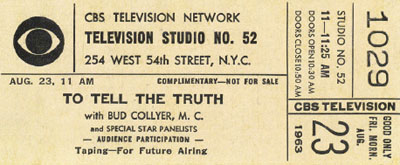
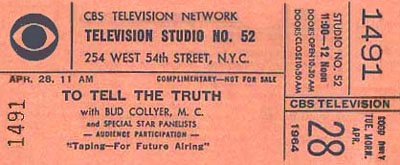
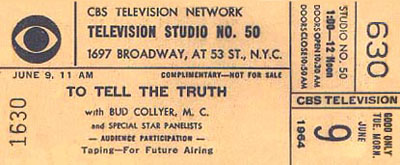
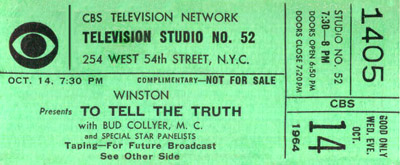
To Tell the Truth had a simple premise: Three people would come out and all claim to be the same person…a person of great interest but not someone who could be identified on sight. One was the real person. The other two were imposters who had been well-briefed by the producers. It was up to a panel of four celebrities to ask questions and try to determine which was the real person of interest.
Created by Bob Stewart, who may have created more successful game shows than anyone else, To Tell the Truth debuted in prime-time on CBS on December 18, 1956. Bud Collyer was the host and it was from the quiz show mill of Mark Goodson and Bill Todman, who were seeking to replicate the success of their What’s My Line? There were a lot of panel/game shows like this in the fifties and To Tell the Truth was unique in this regard: It was one of the few where the home audience didn’t know the answer as the panel asked questions. We at home could play right along with the panel, which usually included four of the following names: Tom Poston, Peggy Cass, Kitty Carlisle, Orson Bean, Don Ameche, Ralph Bellamy, Polly Bergen, Hy Gardner and Johnny Carson.
An odd “vibe” must have been present on the set for some years there. Host Collyer was one of the more outspoken pro-blacklisting voices in AFTRA, the TV performers’ union. He was all for purging TV of performers and staffers with “pinko” connections…but a lot of those folks worked on To Tell the Truth. Mark Goodson was among the few producers willing to stand up to demands that he drop performers who’d been fingered as unAmerican by Red Channels or other such institutions. He’d resisted demands that he fire Henry Morgan off I’ve Got a Secret and he often hired panelists like Orson Bean and John Henry Faulk who’d crossed Red Channels or AWARE. Bean and Faulk won a union election over a Collyer-backed slate on these issues and Faulk later won a major lawsuit over his blacklisting. Still, from all reports, Collyer was a professional and a gentleman to all on To Tell the Truth.
The original To Tell the Truth ended its prime-time run on May 22, 1967. A daytime version which had started in June of ’62 continued on until September of ’68. That was the end of the Collyer version but others would follow.
Camouflage (1961-1962)


One of my favorite game shows when I was a kid was Camouflage, which was hosted by Don Morrow. The premise was pretty simple: There was a drawing with a hidden picture in it. Two contestants competed to try and see who could find the hidden picture first. I remember liking the show a lot but I was ten at the time and I suspect I would have outgrown it if it had been around longer. It was revived by Chuck Barris in 1980 but it was not successful.
Three Times Daley

Three Times Daley was an unsold 1976 pilot created, written and produced by a fine creative talent named John Rappaport who had been one of the main folks behind the M*A*S*H TV series. It was about a home with three generations of males trying to live together: Grandfather, father and son. Don Adams played the father but the proceedings were stolen by a great character actor, Liam Dunn, playing Grandpa. I remember watching it when it aired and finding it very fresh and very funny. When I met John, I asked him why it didn’t sell. He told me he had no idea. That’s how it goes in television…too many times.
Sammy Davis Jr. Show, The
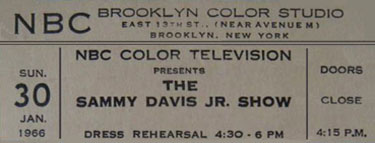
The weird part about The Sammy Davis Jr. Show is how often Sammy wasn’t on it. Sammy had been a frequent guest on other variety shows and specials and hosted a few, all to great success so NBC arranged to give him his own show. The first show aired on January 7, 1966 and got tepid reviews despite a guest list that included Richard Burton and Elizabeth Taylor, Nancy Wilson, Corbett Monica, the dance team of Augie & Margo, and The Will Mastin Trio. Davis himself was reportedly unhappy with the show.
Then the next three weeks, guest hosts filled in for Sammy. Months earlier, he had taped a variety special for ABC that had not been aired. When the network finally scheduled it, they reminded Davis of a clause in his contract that said that he would not appear on any other TV program for three weeks preceding the broadcast of the special. NBC and Davis were furious and accused ABC of slotting the show in a deliberate effort to sabotage his new series. That was probably the idea but it worked. Sammy Davis Jr. had to stay off The Sammy Davis Jr. Show for three weeks which were hosted, one per week, by Johnny Carson, Sean Connery and Jerry Lewis. Davis used that time to work on future shows and to try and revamp the format. It helped a lot and the show got better when he returned to it but the momentum was gone…or something. It was cancelled and the last episode — a one-man show with just Sammy — aired on April 22.
The last three or four episodes of the 15 episodes were produced after the cancellation notice. They were looser with more ad-libbing and Sammy booked guests that he wanted on the show as opposed to guests he was told would help the ratings. Many TV critics thought the series had finally found itself and urged NBC to give it another chance but that didn’t happen. There was talk of another network picking it up but that didn’t happen either. Sammy did a lot of television but didn’t have his own series again until his 1975 talk show, Sammy & Company, which was notorious for how much its guests fawned over each other.
Pat Sajak Show, The
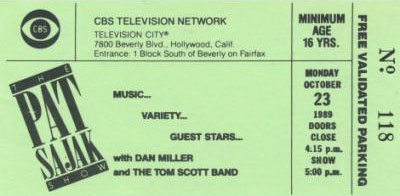
When CBS tapped Pat Sajak for a late-night talk show in 1989, a lot of industry folks wondered about the selection. He seemed awfully lightweight to compete against the mighty Johnny Carson. Then again, Sajak was the host of the enormously popular game show, Wheel of Fortune…and Carson himself had gone from hosting a game show to hosting The Tonight Show. Later on, everyone would say, “We knew it would never work” but not many were predicting that before Sajak’s debut on January 9 of that year.
Initial ratings were strong the first week, less strong the second…and by the time the first month was out, all talk of knocking Johnny off his throne had ceased. Most critics felt the show was Johnny Lite — too much the same format only not done as well. Within CBS, the complaint was that Sajak wasn’t giving it his all; that he still regarded hosting Wheel of Fortune as his “real” job and that hosting a 90-minute late night series was something he did in his free time. Sajak had given up hosting the daytime Wheel of Fortune but had kept the much more lucrative evening syndicated version.
In October of 1989, the show was cut from 90 minutes to an hour. Several CBS affiliates had bumped it to a later hour or were not carrying it at all…and from October on, that was happening at an accelerated pace. It became less a question of whether it would be cancelled as when. Sajak began working four days a week or skipping weeks completely and the show had a succession of guest hosts who were more or less auditioning for the time slot. By February of ’90, CBS was reportedly renewing the show a week or two at a time and on April 13, the last one aired with guest host Paul Rodriguez.
The show was regarded as a large failure but its initial tune-in did convince CBS that it was viable to compete with Carson; that they’d merely picked the wrong guy to do it. They began quietly scouting for the right guy and soon made an offer to Jay Leno, who was then Carson’s permanent guest host. When Leno instead opted to sign a contract with NBC that guaranteed him The Tonight Show upon Johnny’s eventual retirement, CBS went after David Letterman. He did a lot better in the time slot.
That Regis Philbin Show
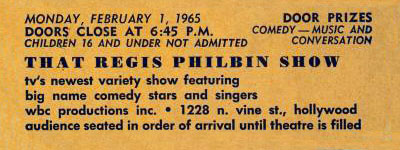
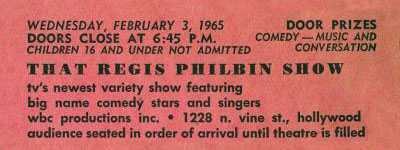
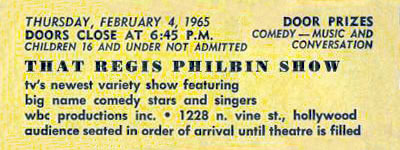
Regis Philbin got his start in broadcasting as a writer for the local news at KCOP TV in Los Angeles. His first on-air opportunity came at a station in San Diego and that’s where he was offered his own talk show. Steve Allen had been doing a syndicated show for the Westinghouse Broadcasting Company and when it went off in 1964, Westinghouse hired Philbin, moved him back to L.A. and offered That Regis Philbin Show to the many stations that had been programming The Steve Allen Show. Some took it, some didn’t…and then those that did began dropping it and That Regis Philbin Show ended in three or four months (accounts differ). Philbin bounced around between small TV and radio jobs until April of 1967 when he was hired as the sidekick on The Joey Bishop Show which ran late night on ABC and which was done from the same building as Philbin’s failed syndicated series. It was the first of many comebacks for the man who would eventually log more hours on television than anyone else.
Brothers, The

The Brothers was one of the 87,000 TV series Gale Gordon appeared on…but really the only one that had him as the lead. It was created when Our Miss Brooks went off and someone at Desilu (probable Desi or Lu) realized that Gordon would be at liberty. So they paired him up with Bob Sweeney, who had previously been in a comedy team with Hal March, and Gordon and Sweeney played two bachelor brothers who operated a photography studio and shared an apartment in San Francisco. Gordon was Harvey Box. Sweeney was Gilmore “Gilly” Box and they kept getting mixed up in each other’s problems and those of their father, played at first by Frank Orth and later by Howard McNear.
Unlike most shows with Gale Gordon on them, this one didn’t last long. It went on the air on October 20, 1956 and went off on September 7 the following year. Gordon went on to other shows. Sweeney segued from performing to directing and was quite successful at it. The show also featured Barbara Billingsley as Gordon’s lady friend. When it was cancelled, she went right over to a fruitful job as the mother on Leave it to Beaver.
Al Jarvis Show, The

Al Jarvis (1909-1970) was one of the first radio disc jockeys in Los Angeles and one of the first to start doing television. Starting around 1947 and continuing through the fifties, he usually had a daily radio program and a daily TV show. The radio one was usually Make-Believe Ballroom and the TV one was either a dance party show, a talk show or some combination of the two forms. The above ticket is from 1952 when he was broadcasting on KECA-TV, which was then the name of the L.A. ABC affiliate. Ob February 1 of 1951, KECA switched over to become KABC.
Candid Camera
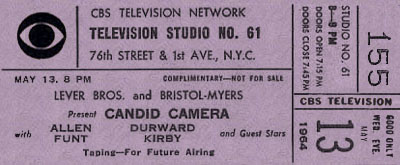
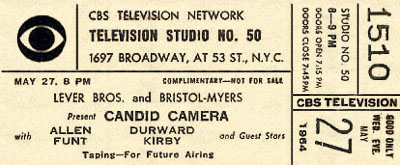
New York born producer Allen Funt started Candid Microphone in 1947 as a series on ABC radio. The premise was pretty simple: Play tricks on people and record the fun with a hidden microphone. The radio show led quickly to a TV version and a series of film shorts, and soon it was all called Candid Camera. Funt and his merry band of tricksters appeared all over the TV dial throughout the fifties, either as a guest spot or a recurring segment on other shows like The Garry Moore Show or The Tonight Show. There was also a short-lived syndicated series.
But the franchise didn’t really take off until 1960 when CBS bought a weekly prime-time series that lasted until 1967. Funt co-hosted with Arthur Godfrey at first, then Durward Kirby and later, Bess Myerson. There were a couple of later syndicated versions but the tickets above are from the CBS run. You’ll notice that though they’re from the same month, they’re for different studios. That’s because Candid Camera was the wandering nomad of the CBS lineup. The network had several studios in Manhattan and Candid Camera would tape in whichever one wasn’t busy at the moment. They could do this because the set was so simple and all the show required was for two people to sit in chairs and talk.
I never cared much for “hidden camera” prank shows but that may be because Funt’s many imitators gave the premise a bad name. None of them ever did it as well.






